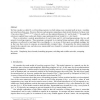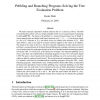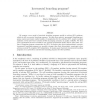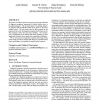DAM
1998
14 years 7 months ago
1998
We first consider so-called (1,+s)-branching programs in which along every consistent path at most s variables are tested more than once. We prove that any such program computing...
TCS
2008
14 years 7 months ago
2008
The replication number of a branching program is the minimum number R such that along every accepting computation at most R variables are tested more than once; the sets of variab...
ECCC
2010
14 years 7 months ago
2010
We give new pseudorandom generators for regular read-once branching programs of small width. A branching program is regular if the in-degree of every vertex in it is either 0 or 2...
CORR
2010
Springer
14 years 7 months ago
2010
Springer
We study restricted computation models related to the tree evaluation problem. The TEP was introduced in earlier work as a simple candidate for the (very) long term goal of separa...
COLT
1995
Springer
14 years 11 months ago
1995
Springer
In this paper, we study PAC-leaming algorithms for specialized classes of deterministic finite automata (DFA). Inpartictdar, we study branchingprogrsms, and we investigate the int...
CSR
2006
Springer
14 years 11 months ago
2006
Springer
We propose a new model of restricted branching programs specific to solving GEN problems, which we call incremental branching programs. We show that syntactic incremental branchin...
COCO
1993
Springer
14 years 11 months ago
1993
Springer
We introduce a linear algebraic model of computation, the Span Program, and prove several upper and lower bounds on it. These results yield the following applications in complexit...
COCO
2005
Springer
15 years 1 months ago
2005
Springer
It is well known that the hardest bit of integer multiplication is the middle bit, i.e. MULn−1,n. This paper contains several new results on its complexity. First, the size s of...
CCS
2007
ACM
15 years 1 months ago
2007
ACM
We present an efficient protocol for privacy-preserving evaluation of diagnostic programs, represented as binary decision trees or branching programs. The protocol applies a bran...
MFCS
2009
Springer
15 years 2 months ago
2009
Springer
We introduce the tree evaluation problem, show that it is in LogDCFL (and hence in P), and study its branching program complexity in the hope of eventually proving a superlogarith...




